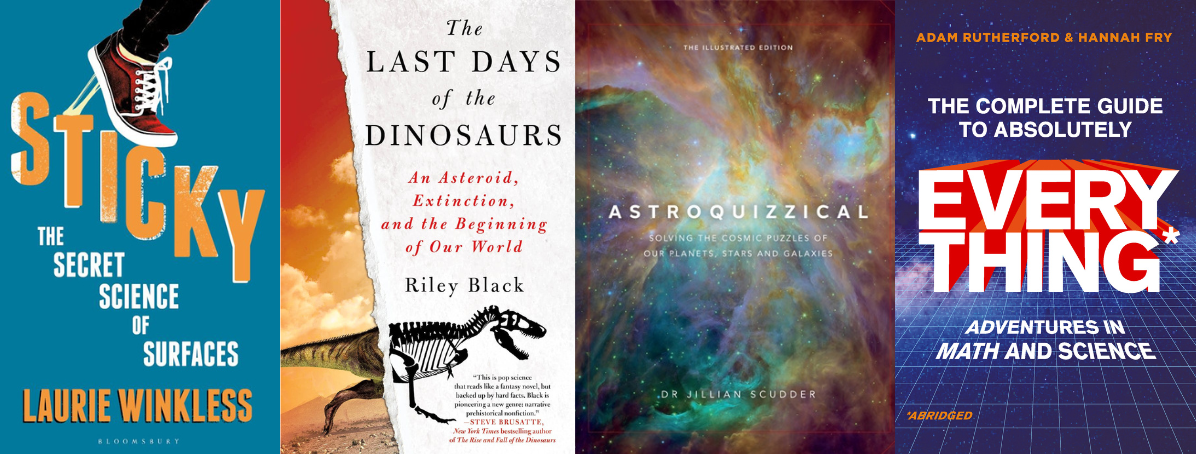Finalists for 2023 Young Adult Science Book Award
AAAS and Subaru are proud to announce the finalists for the 2023 AAAS/Subaru SB&F Prize for Excellence in Science Books in the Young Adult Science Book category. The Prize celebrates outstanding science writing and illustration for children and young adults and is meant to encourage the writing and publishing of high-quality science books for all ages. Longlists for all four categories were announced in October.
The 2023 winner will be selected from among the following finalists:
Astroquizzical: Solving the Cosmic Puzzles of Our Planets, Stars, and Galaxies (Illustrated Edition), by Jillian Scudder. Illustrated by Claire Lenkova. Icon Books, 2021.
A beautifully illustrated, enlightening edition of astronomer Jillian Scudder’s exploration of our universe. Looking up at the night sky, it is almost impossible to imagine that we can trace our common ancestry with the distant stars and galaxies back over 13.8 billion years. Astroquizzical explores this connection by travelling back through the generations of the cosmic family tree, from Earth (parent) to the stars (grandparents), galaxies (great grandparents) and first atoms of the Big Bang (great-great grandparents). On the journey, the reader is invited to become ‘astroquizzical’ by asking the questions and investigating the many scientific mysteries of how the universe was formed and how it works. This updated and illustrated edition combines beautifully curated space images with ten sketchbook ‘thought experiments’ to create a uniquely accessible guide to the science of Earth’s place among the planets, stars, and galaxies.
The Complete Guide to Absolutely Everything (Abridged): Adventures in Math and Science, by Adam Rutherford and Hannah Fry. W. W. Norton & Company, 2022.
Despite our clever linguistic abilities, humans are spectacularly ill-equipped to comprehend what’s happening in the universe. Our senses and intuition routinely mislead us. The Complete Guide to Absolutely Everything (Abridged) tells the story of how we came to suppress our monkey minds and perceive the true nature of reality. Writing with wit and humor, geneticist Adam Rutherford and mathematician Hannah Fry guide readers through time and space, through our bodies and brains, showing how emotions shape our view of reality, how our minds tell us lies, and why a mostly bald and curious ape decided to begin poking at the fabric of the universe.
The Last Days of the Dinosaurs: An Asteroid, Extinction, and the Beginning of Our World, by Riley Black. St. Martin's Press, 2022.
In The Last Days of the Dinosaurs, Riley Black walks readers through what happened in the days, the years, the centuries, and the million years after the impact, tracking the sweeping disruptions that overtook this one spot, and imagining what might have been happening elsewhere on the globe. Life’s losses were sharp and deeply-felt, but the hope carried by the beings that survived sets the stage for the world as we know it now. Picture yourself in the Cretaceous period. It’s a sunny afternoon in the Hell Creek of ancient Montana 66 million years ago. A Triceratops horridus ambles along the edge of the forest. In a matter of hours, everything here will be wiped away. Lush verdure will be replaced with fire. Tyrannosaurus rex will be toppled from their throne, along with every other species of non-avian dinosaur no matter their size, diet, or disposition. They just don’t know it yet. The cause of this disaster was identified decades ago. An asteroid some seven miles across slammed into the Earth, leaving a geologic wound over 50 miles in diameter. In the terrible mass extinction that followed, more than half of known species vanished seemingly overnight. But this worst single day in the history of life on Earth was as critical for us as it was for the dinosaurs, as it allowed for evolutionary opportunities that were closed for the previous 100 million years.
Sticky: The Secret Science of Surfaces, by Laurie Winkless. Bloomsbury Publishing, 2022.
You are surrounded by stickiness. With every step you take, air molecules cling to you and slow you down; the effect is harder to ignore in water. When you hit the road, whether powered by pedal or engine, you rely on grip to keep you safe. In Sticky, Laurie Winkless explores some of the ways that friction shapes both the manufactured and natural worlds, and describes how our understanding of surface science has given us an ability to manipulate stickiness, down to the level of a single atom. But this apparent success doesn’t tell the whole story. Each time humanity has pushed the boundaries of science and engineering, we’ve discovered that friction still has a few surprises up its sleeve. So do we really understand this force? Join Laurie as she seeks out the answers from experts scattered across the globe, uncovering a stack of scientific mysteries along the way.
Winners will be announced in February 2023.
The finalists for the Children’s Science Picture Book, Middle Grades Science Book, and Hands-On Science Book categories were announced earlier in the week.

